#Totally NOT Ricecooker Ginger Agendaist Isopod Activist Rae
Text
试问:这是啥?//Question: what is this?
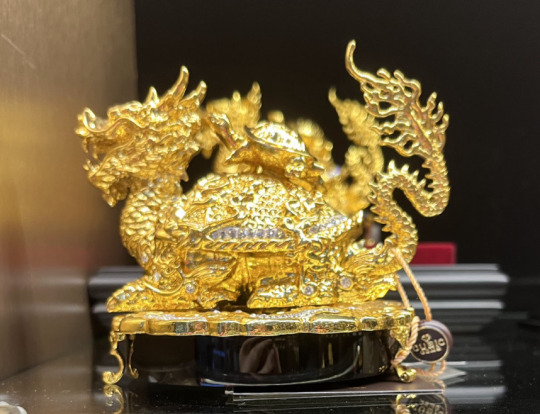
and I only just remembered about these, but I kept seeing these turtle dragon statues around. I need to research them more but honestly, they're so cute I might just call them my 6th favorite type
@secondhanddragon So, you wanted to know what this is?
I went to search for their information and the creature with the highest probability (so high my confidence level is at 99%) of matching the above is...
金鳌,或称龙龟
Golden Ao, also known as Dragon Turtle
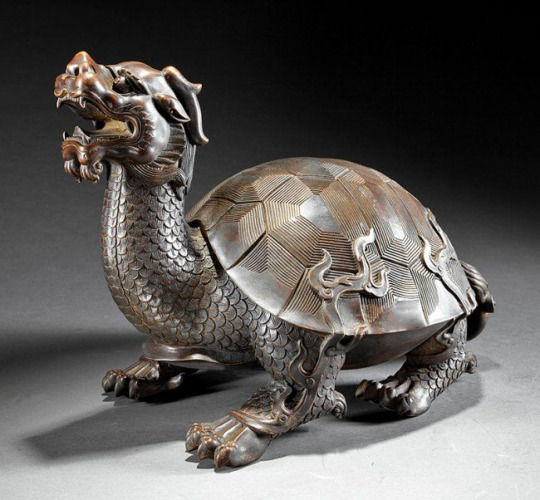
It's classified as a divine turtle (神龟)rather than a dragon; my guess is that since it is not one of the Dragon's Sons, it doesn't count in a traditional bestiary.
It has the shell of a turtle but the body of a dragon, and once again, it's useful in Fengshui. It symbolizes power and wealth.
-----------------------
However! This is not the only turtle-dragon in Chinese mythology. In fact, my Brain's first thought—though we kinda immediately discarded it—was the other one...
赑屃,或称霸下、龟趺
Bixi, also known as Ba Xia ("Dominate Below") and Gui Fu ("Foot Tortoise")
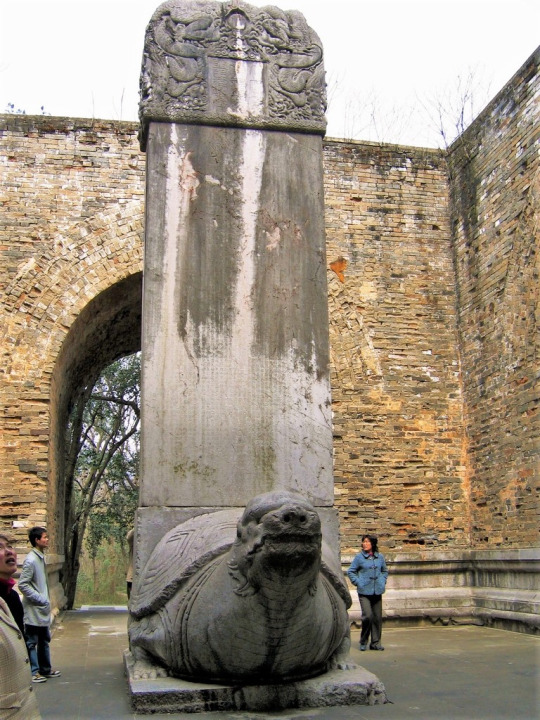
Now this is one of the Dragon's Nine Sons. Bixi is strong; the word 赑 basically means "able to support great weight," but it's not a common word to be used in any stretch. It's the son of the dragon and a tortoise, and later depictions of Bixi gradually show characteristics of a dragon more than its earlier, clearly-tortoise-like features.
How did you rate your confidence level? Why are you sre that the image I showed you was a Dragon Turtle and not a Bixi?
It's the function of Bixi that gave it away!
Bixi is always made to carry steles and important tablets on its back, especially the ones by emperors. The idea is that the deeds and/or names of those recorded on this stele/tablet will live on forever with Bixi, who has the steadfast longevity of a tortoise and the divine power of a dragon.
It possesses quite a few meanings:
power and status; hence its steles are often those of emperors, high chiefs, and whatnot.
longevity, since it is the son of a tortoise
local cultural symbol (local tribal importance)
and mythological symbolism (in Taoism)
One of the myths concerning Bixi is this: Bixi used to carry mountains on its back and wreak chaos through tidal waves. Then, one of China's ancient emperors, Da Yu, subjugated Bixi and made it work under him. Da Yu was known for his Great Flood project—he devoted much of his life to solving it, and in this mythologized version, Bixi was one of those divine creatures who helped*. When the project was over, Da Yu worried that Bixi would return to its old wayward ways, so he created this gigantic stone tablet detailing Bixi's contribution and great deeds and asked Bixi to carry it around. The weight of that tablet caused Bixi to be too sluggish to wreak havoc anymore.
*You might be interested to know that another one who helped Da Yu was "Ying Long (应龙)"—yes, this is a full-fledged dragon.
This is how I'm confident that your image was that of a dragon turtle and not a Bixi.
---
How do I distinguish between a Bixi and Black Tortoise (Xuan Wu 玄武)?
Same deal. It's the stele/tablet. Also, Bixi has teeth. Tortoises do not. Later Bixi has draconic features. Xuan Wu is always... a tortoise! Hahahaha.
----
So there you go. I'm most confident that it is a dragon turtle. However, Bixi has more stories to it due to being a Son of the Dragon.
As a rule of heuristics (not statistics; I did not collect data for this), if a Chinese myth creature is found as a small, delicate ornament, it's quite likely that it has connotations in Fengshui. It's the same for Pixiu and Qilin, and the same for dragon turtles too.
Thank you for reading my ramble! I hope it was fun and informative for you!
----
Citations and Links:
"Dragon Turtle" in Wikipedia.
"Bixi" in Wikipedia.
"金鳌 (中国古代神兽)" in Baidu Baike. (In Chinese)
"赑屃(中国古代神兽)" in Baidu Baike. (In Chinese)
Kafka's Notes: I generally don't like Baidu Baike because it lacks citational rigor, so it's hard to trace information to its source. However, it was very useful for me to search for names and preliminary information, so I included it here. Some of the stuff I mentioned (like the Legend of Bixi and Da Yu) was from Baidu Baike; I judged that a folklore is not always recorded in academic sources, so this instance of lacking citational rigor is acceptable.
#Yo should I count this as a high-quality ramble? It's got citations! Research!#If it counts. Then I am making progress in one of my New Year Resolutions already!#Totally Not Ricecooker Ginger Agendaist Isopod Activist Rae#ramble with citations
15 notes
·
View notes
Text
破蛋日快乐!你的礼物是:为什么龙会戏珠?//
Happy Hatching Anniversary! Your present is: why do Longs hold pearls?

@secondhanddragon So, you wanna know why?
To be honest, while I was trawling for information, I realized that not even that many Chinese sites talk about the pearls. Such might be the nature of folklore—everyone gives their own interpretations, which are then spread orally. Tough to find "academic sources." And of course, wonky citations with broken links and poor reference points are always a hindrance.
"神龙戏珠" (The Divine Dragon Playing with Its Pearl) is a motif that has a few variations. It could be a single dragon (单龙戏珠), two dragons (二龙戏珠), three dragons (三龙戏珠), and even multiple dragons chasing one single pearl (多龙戏珠) [1].

In this figure, you can see five dragons chasing a single pearl. [1]
-------
#1: The Pearl... Really Is a Pearl!
Pearls are formed by living shell mollusks—which are members of the "aquatic tribes" [2]. They are hard to come by, lustrous, pretty as fuck, and very beloved in Chinese culture.
Chinese dragons, unlike the Western ones, are associated with water, right? That's because Long is "the king of the ocean" and it "rules over all aquatic tribes" [2]. If your dime-a-dozen clam could produce something as precious as a pearl, why can't the King itself produce the most beautiful and precious pearl that triumphs them all, huh?
This appears to be the genesis of the concept of the "Pearl." But naturally, as time goes on, more and more meanings are embedded in it!
----------
#2: The Pearl as an Egg
Long is a chimera of sorts. It's an amalgamation of, inter alia, a fish, a crocodile, a snake, a boar, a horse, an ox, a lizard, and a deer [1] [2]. Fishes and the reptilian reps in this group lay eggs. The crocodile's egg is even kinda big—way larger than a pearl.
Do you see? The egg is seen as a pearl and vice versa [1] [2]. Eggs are the source of life for crocodiles and snakes, and therefore, egg-pearl represents life in dragon arts [2]. When the dragon is "playing with its pearl," it's actually playing with "life." This motif embodies the dragon's status as a protector and caretaker of life [2].
Almost like a parent would...
---------
#3: The Pearl as a Symbol of Love for the Dragons' Children
Now, some might think that all Longs are male, as the mythical creature symbolizing women is often the Fenghuang (and so one might think that all Fenghuangs are females). That's not true. Dragons and Fenghuang both have two, uh, sexes.
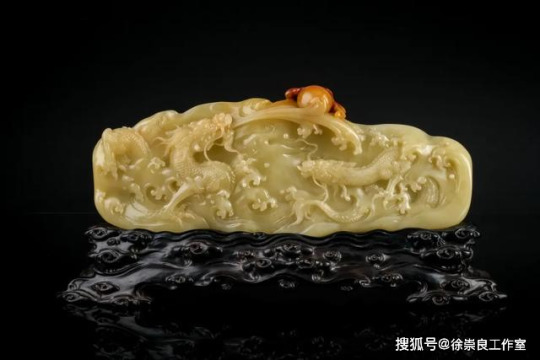
This figure shows two dragons "playing" with a pearl. [1]
The "Two Dragons Chasing a Pearl" motif is popular in classical Chinese artwork. One of the dragons is male, and the other is female. The Pearl symbolizes egg/life, as stated in #2, which means the Pearl also comes to symbolize "a child" [1] [2].
In other words, Papa Dragon and Mama Dragon are playing with—and stealthily protecting—Anya Pearl.
An important note that isn't stated in any of my citations, but is nonetheless relevant: Chinese people may call themselves 龙的传人, "The Dragon's Heir." It means—as mythical origin goes—the Chinese people identify as "the children of the Long." Now connect this to what you learned in #3.
-------
#4: The Pearl as the Sun
Sometimes the Pearl is ON FIRE!!!
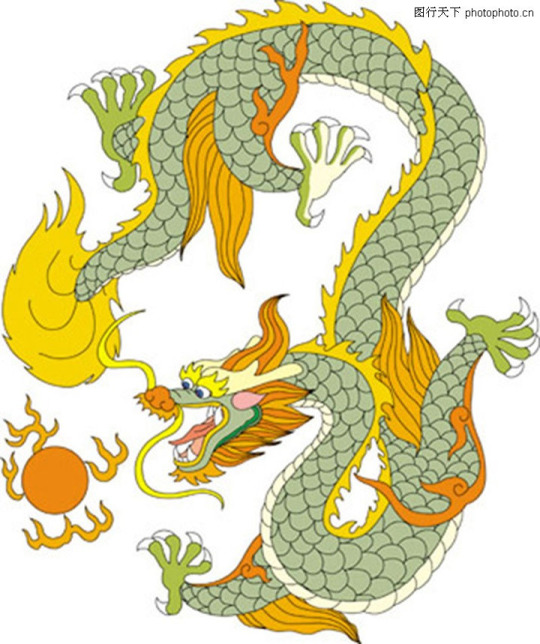
This is especially predominant in the aforementioned "Two Dragons Chasing a Pearl" motif. The Pearl looks more like a fireball than an actual pearl. Below the Pearl, then, one may find a depiction of the sea.
"The Pearl leaps out from the ocean." What does that connotate? The rising sun [2]!
Now, what does it have to do with the dragon? Well, have a little detour.
The Four Symbols (四象)
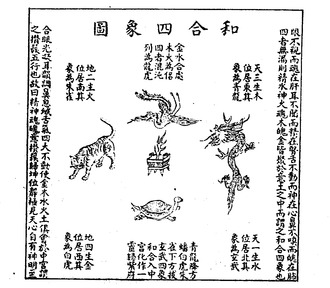
You might have already heard of this, but in case you didn't: each cardinal direction has a "guardian."
东方青龙 // Azure Dragon of the East
西方白虎 // White Tiger of the West
南方朱雀 // Vermillion Bird of the South
北方玄武 // Black Warrior (or Black Tortoise) of the North
They represent more than just directions—they have their own traits, backstories, virtues, etc.
Who's the Guardian of the East? The Azure Dragon!
Now, drawing our discussion back to the Pearl, you can see why the dragon chases after it now, right? The Pearl is the Sun; it rises from the East. The Guardian of the East plays/chases after it as an emblem of ancient Chinese worship of the Sun [1] [2].
-------
#5: The Pearl and the Dragons Representing Chinese Aesthetics [1]
Chinese art loves "wholeness" and "pair."
You often find a pair of things in Chinese culture: a pair of Door God, a pair of Chinese duilian (poetry of sorts; used for blessings and wishes), the likes. Chinese culture also really loves things like the full moon, because "roundness" symbolizes the whole, unity, and consummation.
Two dragons form a pair. In front of them, an orb—a round, whole object. Hence, the motif is well-beloved as it features two of the Chinese culture's favorite aesthetics [1].
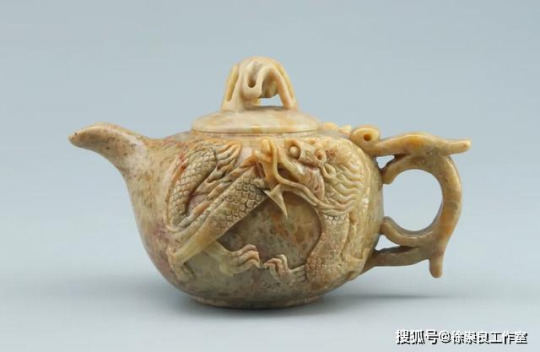
Kinda hard to tell, but two dragons are playing with the pearl here.
------------
And that concludes the answer to your hundred-year enigma, haha! To the best of my ability, anyway. I sure hope it's been a blast to read.
More importantly, happy birthday, @autistic-beanmonster2!
I have been saving this up for a ramble just for you, but I couldn't find the time to write it. I'm sorry; I really planned to show this to you the moment the time struck 12 am in your time zone through the power of "scheduled post," but... let's just say I've been hit by a hindrance. Oops!
Well, does it matter if I'm just a bit late?
Thank you for reading my ramble!
-------------------
Citations:
神龙戏珠,所戏珠子为何?("The Divine Dragon Plays with Its Pearl; What is that Pearl?") by 徐崇良工作室, essay on Sohu.com [in Chinese]
龙的嘴里为什么要含着珠子 (Why does the dragon have a pearl in its mouth") answered by an anonymous user on wenwen.sogou.com [in Chinese]
The question that produced this ramble is originally found here.
#Totally NOT Ricecooker Ginger Agendaist Isopod Activist Rae#chinese dragon#dragon#ramble with citations#<- yea. I think I should designate an organizational tag for rambles I put effort in citations and stuff.#makes it easier to count how many good rambles I've made#so I can see if I meet my New Year Resolutions
4 notes
·
View notes